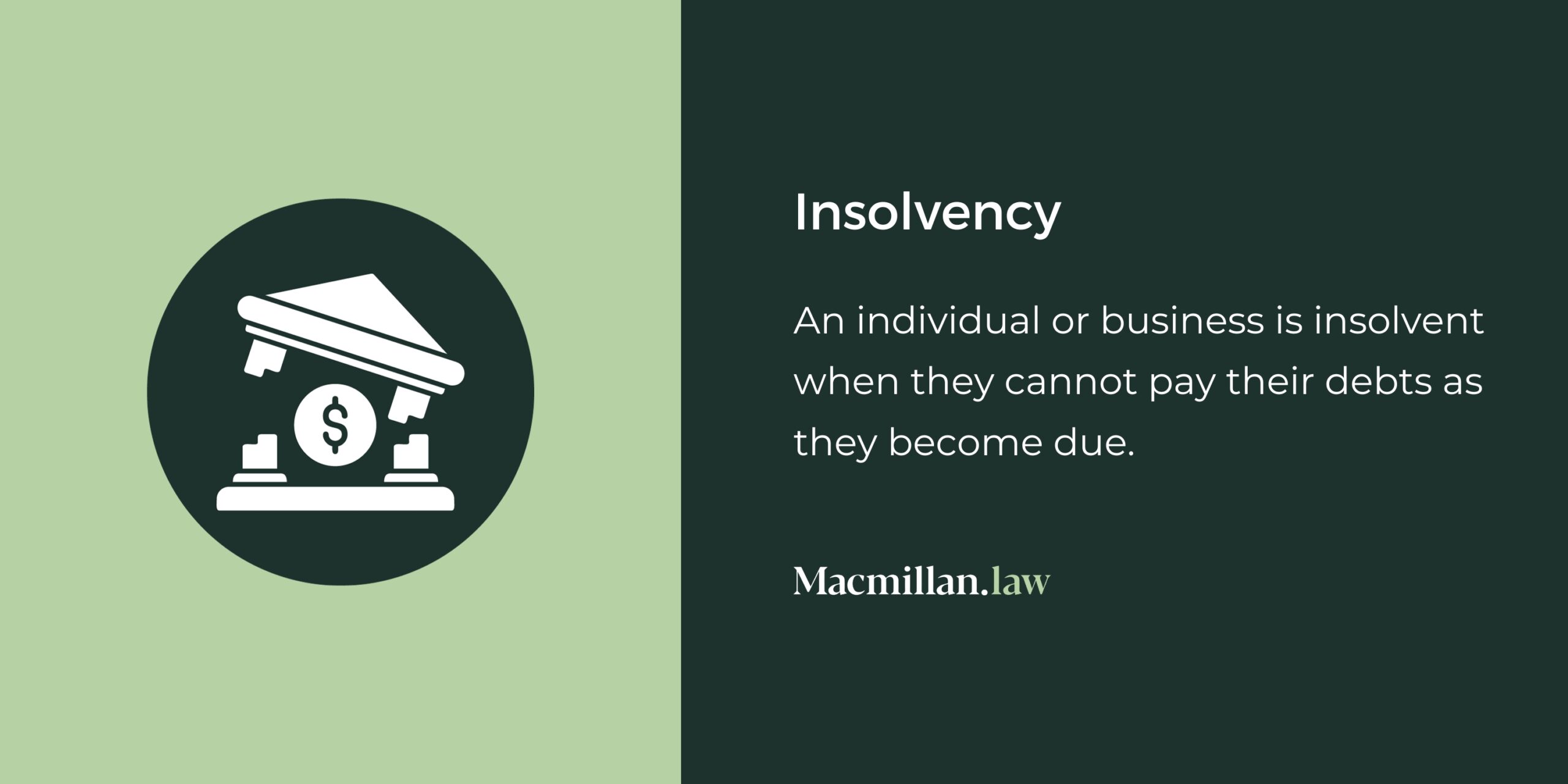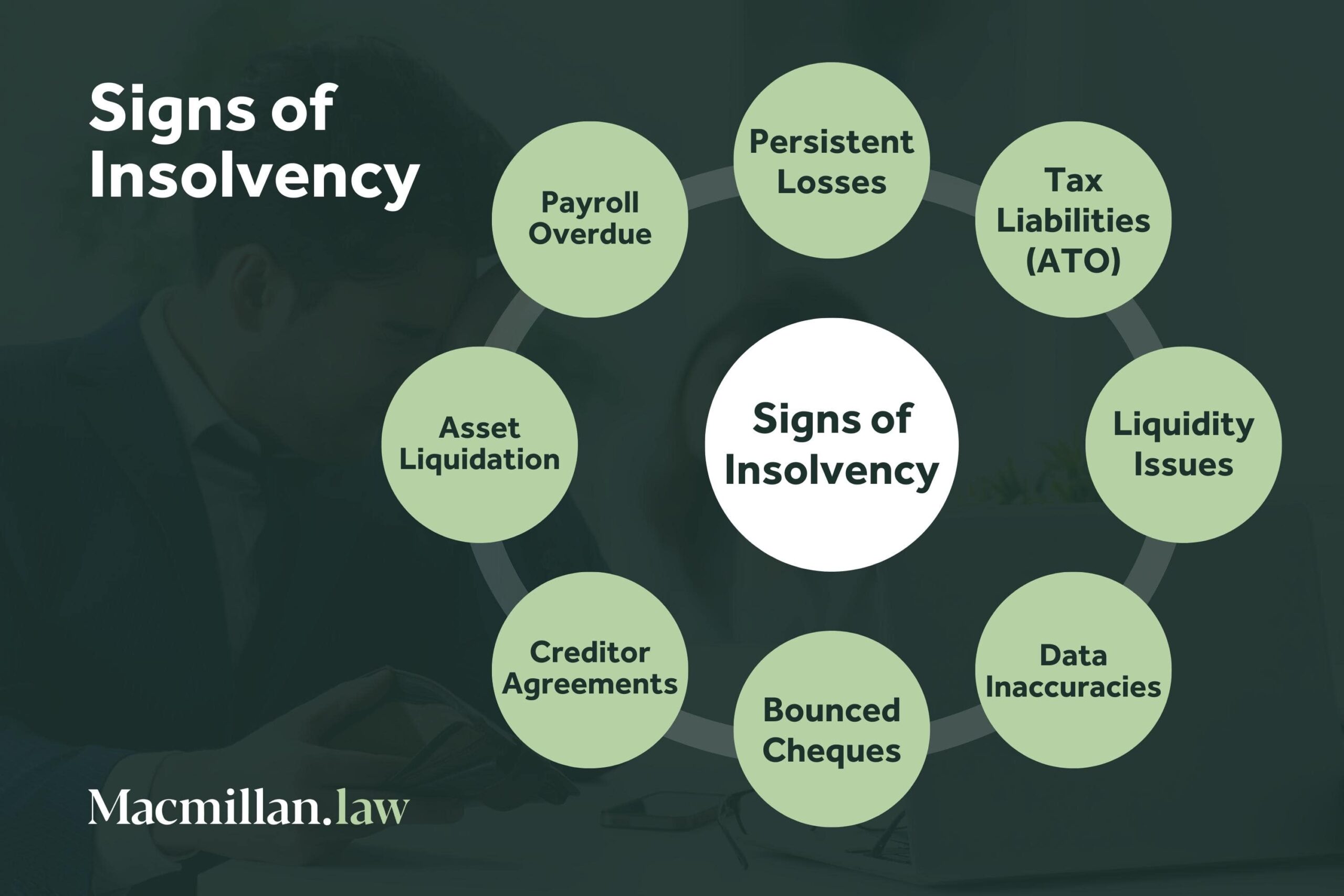
Insolvency: Australian Legal Definition & Meaning
Find out in 2 minutes if you need insolvency help.
What is Insolvency?
An individual or business is considered ‘insolvent’ when they are unable to pay their debts as and when they fall due. By comparison, if an individual or business has cash flow available to meet their financial obligations, they are considered ‘solvent’.
Insolvency can strike at any time for a number of reasons, some within your control and some outside of your control, for example, a rise in suppliers' costs, market trends, changed government regulations and other factors causing loss of business.

Understanding Corporate Insolvency in Australia
Corporate insolvency in Australia is a multifaceted process, allowing businesses in financial distress to explore different avenues depending on their specific situations.
- External Administration: At its core, external administration encompasses various procedures including administrations, receiverships, and liquidations. A company usually enters this phase due to debts owed to creditors. This can be initiated by the company's directors voluntarily or by creditors involuntarily.Voluntary Administration: This method is not a liquidation but is aimed at addressing the company's debt issues swiftly. An independent third party, the Administrator, takes over the directorial roles temporarily to assess potential solutions and outcomes for creditors. The main objective is either to ensure the company continues its operations or to achieve better returns for the company's creditors and members.Liquidation: This involves winding up a company's affairs, typically by a liquidator, to give creditors a fair opportunity to recoup their debts. Two primary forms of liquidation are:a. Creditors' Voluntary Liquidation (CVL): Initiated when a company's shareholders deem the company insolvent or nearing insolvency, leading to an orderly asset realisation and distribution among creditors.
b. Court Liquidation: Triggered when a creditor (or several) makes an application to the court, mostly after exhausting other payment avenues, leading to an organised asset realisation and distribution to the creditors.
- Receivership: This comes into play when a secured creditor wants to reclaim their loan or when an interested party, like a director or shareholder, intervenes. Receivers, appointed by the court or the secured creditor, take control to ensure the creditor's repayment from the sale of assets. This process ends once all or sufficient assets are sold, and the company, if not under any other external administration, reverts to its directors.
| Insolvency Procedures | Key Facts |
|---|---|
| External Administration |
Refers to insolvency appointments: administrations, receiverships, liquidations. Can be initiated voluntarily by directors or by creditors. |
| Voluntary Administration (VA) |
Company appoints an independent third party (Administrator) due to financial hardship. Aim: save the company, not liquidate. Process usually lasts between 2530 business days. |
| Creditors’ Voluntary Liquidation (CVL) |
Initiated when a company can't meet its debts. Allows for orderly asset realisation, investigations, and distribution among creditors. |
| Court Liquidation |
Occurs when a creditor seeks to windup a company in court. Follows company's failure to respond to a creditor's statutory demand. |
| Receivership |
Appointed by secured creditors or an interested party like a shareholder or director. Aim: recover loans or assets to repay the secured creditor. Ends once receiver collects and sells enough assets or resigns/is discharged. |
For any company navigating these complex insolvency paths, it's paramount to consult with professionals, such as Macmillan Lawyers and Advisors, to ensure a proper understanding and to receive the best advice tailored to the company's situation.
Signs of Corporate Insolvency

Common causes and signs of insolvency include:
- Persistent losses across multiple financial reports
- Challenges in obtaining loans or securing financial assistance
- Outstanding tax liabilities (overdue tax debt with the ATO)
- Unfavourable liquidity ratios
- Failure to provide prompt and precise data on the company's financials
- Frequent instances of bounced and post-dated cheques
- Special agreements with selected creditors
- Liquidation of non-current assets such as land or equipment to ease working capital shortages
- Failure to fulfil employee payroll commitments, including superannuation contributions
- Abandoning fixed payment terms with creditors, adopting an arbitrary approach to settling debts
- Lack of a comprehensive financial strategy or budget
- Operational inefficiencies brought on by lack of cash liquidity
Personal Insolvency and Bankruptcy
Bankruptcy is a complex legal procedure designed for individuals facing insolvency, which means they cannot meet their financial obligations as they fall due. It serves as a protective measure both for debtors and creditors.
When someone declares bankruptcy, a Registered Trustee takes control of their finances and assets, ensuring balanced protection for all parties involved. The trustee's primary role is to dissect the debtor's financial situation, manage asset distribution to the creditors, and ensure the debtor is shielded from any further legal pursuits by most creditors. This process ensures that the bankrupt individual is relieved from the majority of their debts while ensuring that creditors have a fair opportunity to recoup what they are owed.
Voluntary vs Forced bankruptcy
Entering into bankruptcy can either be voluntary or forced. An individual can opt for voluntary bankruptcy by submitting a Debtor’s Petition along with a Statement of Affairs to the Official Receiver or a Registered Trustee. This route is commonly taken when personal debts become unmanageable, personal guarantees on company debts are invoked, or when the individual faces escalating demands from creditors.
Conversely, a creditor can enforce bankruptcy upon a debtor through the Federal Court. This is initiated with a Creditor’s Petition, which can be launched if a debt of at least $5,000 remains unpaid, among other criteria.
The consequences of bankruptcy
If an individual does opt for self-declared bankruptcy, it's not a decision to be taken lightly. The procedure and subsequent consequences are significant. Before making this significant decision, consulting with an insolvency lawyer is paramount. Contact Macmillan Lawyers and Advisors for a free 30-minute phone consultation.
While the duration of a bankruptcy is typically set at 3 years and 1 day, certain non-compliance issues can extend this period. Post-bankruptcy, the individual's details are permanently registered on the National Personal Insolvency Index (NPII), a public ledger. Furthermore, credit reporting agencies maintain bankruptcy records for at least 5 years.
Considering the implications and the permanence of some bankruptcy records, seeking professional advice, such as from firms like Macmillan Lawyers and Advisors, is crucial if you are considering bankruptcy.
Seeking Insolvency Lawyers and Advisors?
Our experienced insolvency lawyers are available nationwide, and we have a significant presence in several major cities. These cities include:
-
Brisbane
-
Sydney
-
Perth
-
Adelaide
-
Canberra
-
Melbourne



FREE INSOLVENCY CHECK (takes 2 minutes)
🔒 Discreet and free review of your insolvency situation.
Contact us today.
We are here to help.
07 3518 8030
[email protected]
Level 38,
71 Eagle Street,
Brisbane QLD 4000
Join us for a free consultation.
Fill out the form below, upload any relevant documents and enter your preferred time for us to contact you.

